Menu
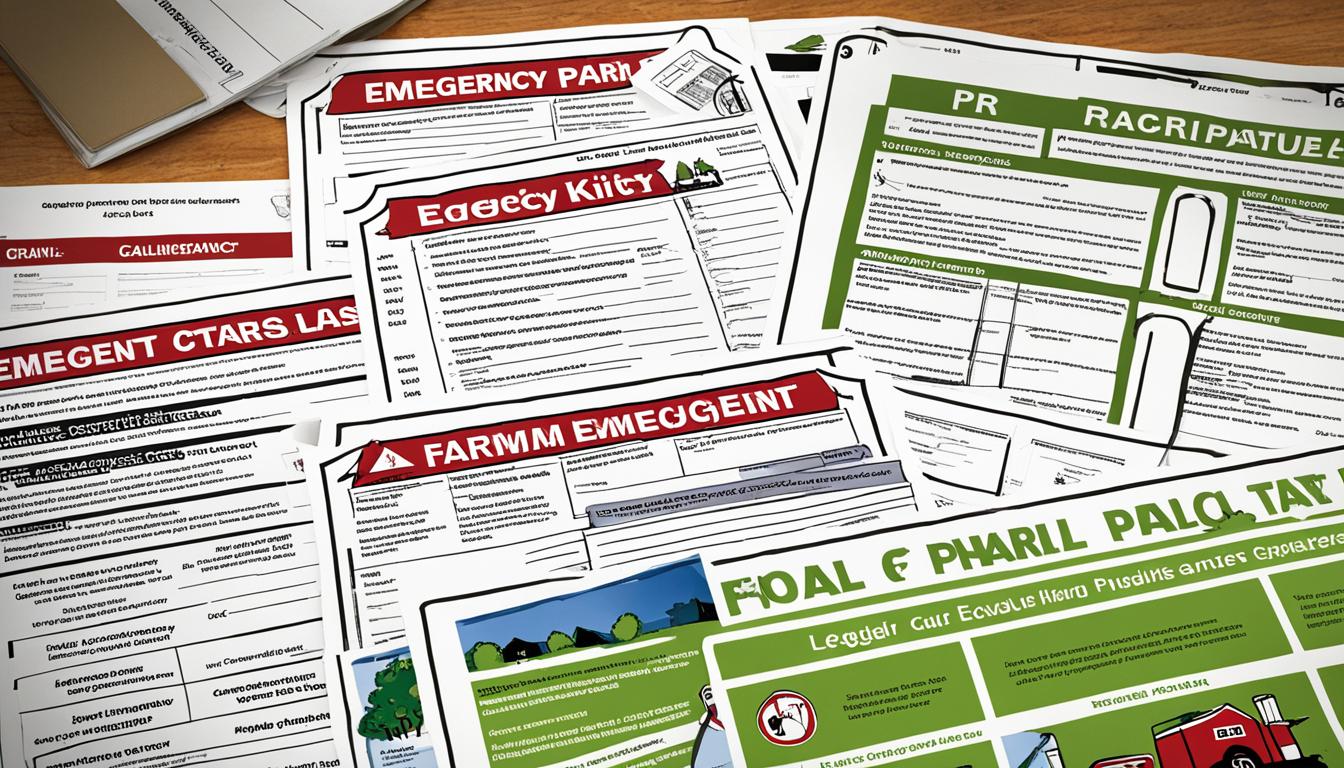
Did you know that spills on farms must be reported to authorities within 15 minutes? This time frame shows how vital it is to act fast during emergencies. As a farm owner, I’ve learnt that we must not only protect our farm and people, but also follow strict laws for emergencies.
Creating a detailed emergency plan means looking at all possible dangers. It’s good to have spill kits by sprayers and mixers to stop water pollution. These plans should be kept where they’re easy to get in an emergency and shared with local emergency services.
The Michigan Emergency Tube is a great tool for keeping emergency plans safe and dry. This way, emergency teams can get the info they need fast. Making sure to update these plans each year, or when your farm changes, is very important to be ready and legal.
Farm emergency planning is key to handling threats, like natural disasters or accidents. It involves looking at risks and setting up a clear response plan. The main goal is to keep people safe, reduce damage, and protect the land. By making sure the plan follows the law, it’s stronger.
It’s crucial to share the emergency plan with everyone on the farm. Hold meetings to talk through the plan regularly. Ask local emergency teams for advice by walking them through your farm.
Make sure everyone knows their role in the emergency plan. Have copies kept in different easy to reach spots. This could be the farm office, tractors, or in waterproof boxes.
The plan must list important numbers for help, like hospitals and fire services. It should also have contacts for vets and poison control. Keeping this info up to date is very important.
Also, the plan needs steps for dealing with spills, as per the law. Always report spills right away to the right authorities. Record everything and let people know quickly. Following these steps is crucial for the farm’s safety.
Looking at possible farm dangers is key for handling crises in farming. By spotting and knowing these dangers, you can pick the right steps to take in emergencies. This makes sure people and the environment stay safe.
Many dangers on farms come from big machines, farming chemicals, and animals. Just in 2018, the U.S. Bureau of Labor Statistics said 146 people died in tractor accidents. This shows how risky machines can be. Farm chemicals like pesticides and fertilisers, vital for growing crops, are also very dangerous. They can hurt people or the environment. Animals on farms, like cows and sheep, can also cause harm. They might bite, kick, or spread diseases. Having the right emergency plans can help cut down on these dangers.
Natural disasters are a big threat to farms. Things like floods, droughts, and storms are happening more because of climate change. These can ruin crops and start fires. Farms need to prepare for these disasters. This is vital to lessen the harm on the farm.
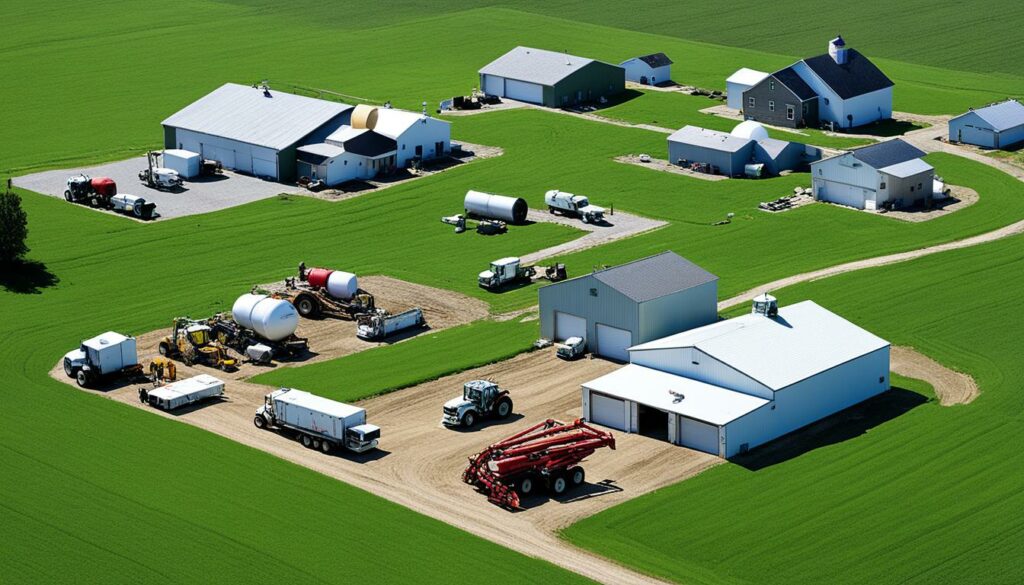
Groups like OSHA, USDA, and EPA in the U.S. help make farm work safer. Following their advice is smart for dealing with both human and nature-caused crises. Knowing about all the possible dangers helps farmers make good emergency plans. These plans keep their farms running well and safe for everyone.
It’s vital to know the legal obligations for farm emergency preparedness. Farm owners must make sure their farms can deal with emergencies. They must follow regulatory compliance in farm emergencies. This includes many important tasks.
One key step is to report spills to the proper authorities. This helps reduce harm to the environment. I also have to handle agricultural chemicals safely. This means storing, using, and getting rid of them correctly to avoid accidents and harm.
Working with government agencies is crucial for emergency readiness. State health agencies often lead efforts in rural areas. They can offer advice and support during emergencies. Knowing and following these laws is also critical to stay out of legal trouble.
Rural areas often lack resources like equipment and training for emergencies. This makes knowing legal responsibilities even more important. During an emergency, rural hospitals and responders may face challenges. Working closely with health, police, and fire departments helps everyone prepare better.
Vital in rural areas are volunteers. But, if they are not well trained or if they leave, it can hurt emergency services. To manage this, having good training and plans for communication is a must. This ensures that emergency services run smoothly.
| Critical Steps for Compliance | Rural Challenges |
|---|---|
| Mandatory Spill Reporting | Limited Equipment and Supplies |
| Safe Management of Agricultural Chemicals | Inadequate Training and Infrastructure |
| Engagement with Federal and Local Agencies | Financial Challenges for Rural Hospitals |
| Training Activities Involvement | Demographic Challenges and Infrastructure Deficits |
| Communication Contingency Planning | Volunteer Reliance and Staffing Turnover |
In conclusion, following the legal obligations for farm emergency preparedness is key. It makes farms more ready and able to manage emergencies effectively. It ensures farms are resilient and can cope with emergency situations.
Farm emergencies require owners to follow strict rules from state and federal agencies. These rules help reduce risks to the environment and safety. It’s key to stay updated on changes, like the bulletin update in October 2014 with a new farm plan template.
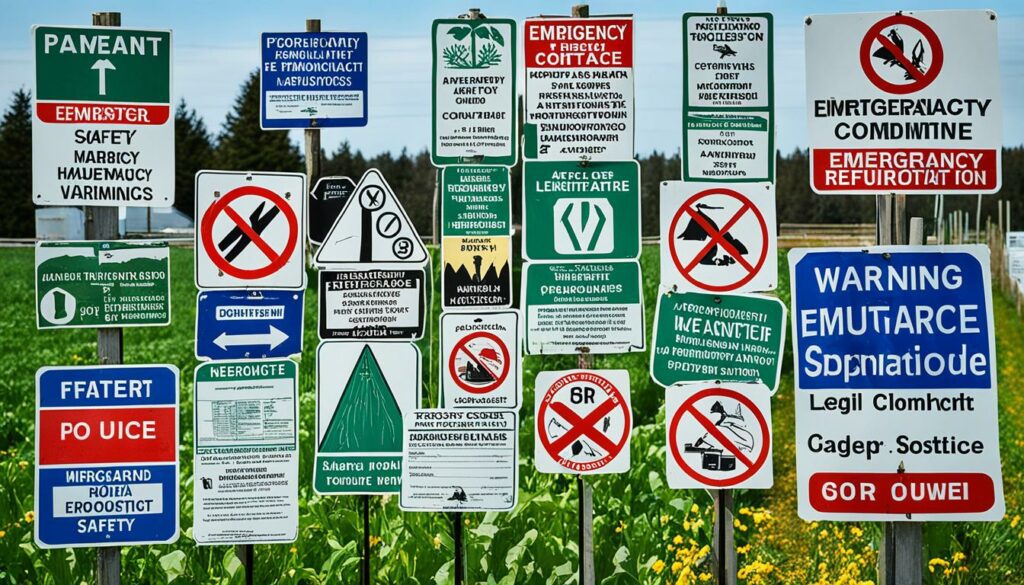
Having a detailed emergency plan is crucial for every farm. This plan must be checked and updated every year or after big changes. Talking with local firefighters or emergency teams about your plans improves how ready you are for emergencies.
All farms need to keep their emergency plans in three places. It should be with the Local Emergency Planning Committee or the fire department, in the farm office, and in tractor cabs. Putting the plan in these spots makes it easy to find when needed. Also, in Michigan, the Emergency Tube project helps by sharing farm plans with emergency teams, helping them act faster.
For farm emergencies, having spill kits is vital. Inside these kits should be gear to protect yourself, materials to clean up, fire tools, and emergency contacts. Any spills must be reported quickly to the right authorities as part of the emergency plan.
The Guide for All-Hazard Emergency Operations Planning gives a framework for making emergency plans. It says who should help, what they’ll use, and when – covering before, during, and right after emergencies. This updated guide ensures farms are ready for any crisis.
The SLG 101 explains how to make a plan that meets the law’s requirements. It focuses on making risks smaller while handling and fixing problems after they happen. It also tells how to work with the Federal Government during big disasters. This guide is different because it talks about certain dangers and what farms should do in those cases.
Local and federal agencies are key in farm emergency response. In disasters, the Federal Emergency Management Agency (FEMA) is vital for help. It deals with huge damage, overloading local resources and affecting the economy. This shows how important it is to plan for emergencies on farms.
FEMA gives advice and help during big disasters. It manages everything from minor issues to huge emergencies. After severe disasters, FEMA helps with medical care, food, and housing. Farms can use FEMA’s plans to be more ready and tough.
The Small Business Administration (SBA) gives disaster loans for farms hit hard by disasters. These loans help recover by fixing or replacing what’s been damaged. They are a crucial part of helping farms keep going in tough times. This aid lets farms go back to normal and keeps their business running.
Talking to these agencies is smart for farm owners. They offer good methods and help improve emergency plans. By working with FEMA and SBA, farms can be better prepared and cope well in emergencies.
Having a detailed farm emergency plan is vital for any caretaker. Emergencies can happen without warning. It’s important to have clear steps to keep the farm and everyone safe.
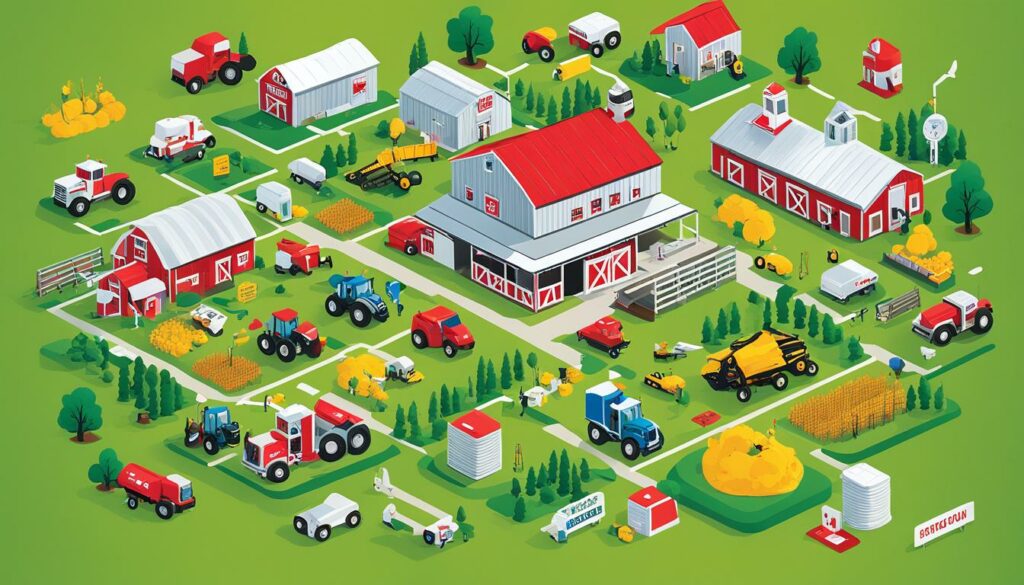
Good emergency plans cover five important areas:
Emergency plans need regular check-ups. It’s important to review and update them each year. Include any new risks or changes to keep the plan working effectively. By making little improvements often, your farm will be ready for anything.
It’s vital for farm owners to understand legal liabilities in farm emergency situations. This is especially true with farms that welcome visitors. Guests might not realise the dangers on a farm, increasing the chance of accidents. From encounters with animals to using machinery, these risks push farm owners towards more legal risks.
Every farm has its own set of safety concerns. These can be lessened but rarely fully eliminated. The rules and legal duties differ from place to place, but the key idea is to have a plan for every activity. This helps lower the risks. Safety concerns can include things like parking and farm animals.
Yet, many factors can still cause serious problems. Take the 1998 ice storm in the U.S. Northeast as an example. This event highlighted the critical need for reliable farm generators. Farms without good generators suffered heavy losses and harm to their animals due to power outages.
The legal implications of farm emergency planning go further than just reducing risks. Not following the rules during an emergency can lead to big fines. Regular checks and keeping safety systems up to date are key. This keeps the farm safe for all its visitors.
Also, the risk from diseases like Foot and Mouth Disease shows why strong emergency plans are crucial. Working with local, state, and national agencies to prevent these diseases is important. It helps protect the food supply and trade.
For farm owners, handling legal liabilities in farm emergency situations means knowing the law and following it closely. Being ready can save lives, protect the farm’s assets, and avoid legal trouble.
Farms need good insurance as part of their emergency planning. They face many risks, like losing property or facing legal issues. But, understanding insurance policies can be hard for farmers. Knowing what’s in your policy, like the Declaration Page or Exclusions, helps farmers use their coverage well.
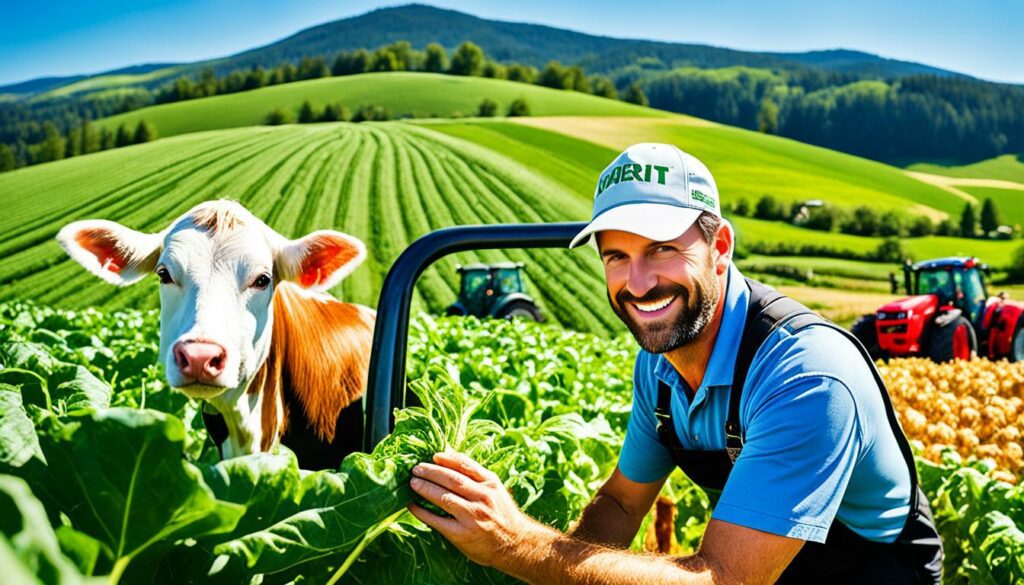
Farm insurance often doesn’t cover everything. It usually won’t pay if the damage was done on purpose, by nature, or from diseases. As a major part of farm insurance, liability coverage helps with costs if someone gets hurt or property is damaged. Then, there’s coverage for property loss which helps with damages to buildings or in losing farm equipment.
Farm insurance can provide different levels of coverage:
Policies can include extras, called endorsements, for more protection. For instance, the Federal Crop Insurance Program in 2021 provided extensive farming coverage. It covered a big chunk of U.S. farms, totaling 284 million acres yearly. This shows how important insurance is for farmers.
More and more, farmers are using revenue-based policies in the last decade. These policies are crucial when it comes to dealing with droughts or too much rain. Since 2000, droughts have caused 42.1% of insurance claims. This underlines the importance of having a wide-ranging insurance policy for farms.
Knowing and reviewing your insurance policy is key in farm planning for emergencies. This helps farms stay safe from unexpected events. Farm insurance plays a big role in making sure farms can last for the long term.
Being ready to react to spill emergencies on a farm is crucial. Farms use chemicals a lot, which makes them more at risk. These chemicals can come in forms like vapours, sprays, or solids, putting people, animals, and plants in danger.
A good spill kit is a key part of your emergency plan. It should have things like absorbents, protective gear, and tools to stop the spill from spreading. The Iowa State University says it’s essential to use, handle, and store chemicals carefully to avoid spills.
It’s important to report farm spills quickly to the right authorities. Laws mean spills must be reported promptly to limit their harm and start fixing the problem. Following these rules is vital to stop health issues and protect the environment.
When a chemical spill happens, it’s critical to act fast and carefully. Remembering to be cautious, control the spill, and clean it up right can help avoid legal trouble. It also keeps the farm safe for everyone.
The legal issues in farm emergency planning are very important. They’re key to keeping farms running well. The first step is to make a detailed emergency plan. This includes naming possible dangers and giving jobs to workers in case of an emergency. This kind of planning makes it less chaotic when a real problem happens and helps keep the farm safe from a legal standpoint.
If a farm doesn’t have an emergency plan, it could face big legal consequences. These could be fines, orders to stop working, or even facing criminal charges. In farming, it’s crucial to have plans for moving people and animals away from danger. It’s also important to make sure everyone can get to important information easily in an emergency. And, having a map that shows emergency teams around and where dangerous things are can lessen the farm’s legal problems if there’s a crisis.
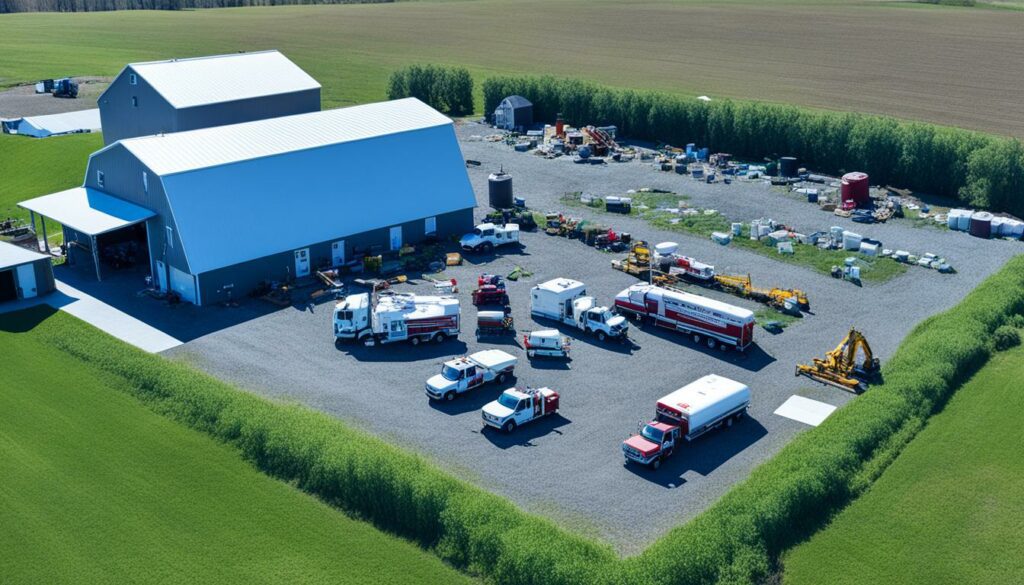
To make sure everything is legal, farms need to work closely with local emergency services like the fire department. Meeting with them to go over emergency plans is not only the law but helps the farm be ready for real emergencies. Also, giving emergency maps to these teams lets them know where to go and what to look out for. This helps speed up their response and can reduce legal trouble for the farm.
Lessons from past emergencies can really help improve a farm’s emergency plan. By studying these cases, farm owners can make their emergency plans even better. For example, they might use maps to mark important spots or put dangerous things in safer places. Taking these steps helps reduce risks and keeps the farm in line with the law.
It’s vital for farms to deal with legal aspects of emergency plans early on. This means making sure all documents and roles are clear. Farms have to follow many state and local laws. They must also keep up with rules on things like where they can build or what they can do on the land they are using. So, it’s important to pay attention to legal details right from the start of emergency planning.
Here’s a breakdown of some critical considerations:
| Consideration | Impact |
|---|---|
| Emergency Action Plan | Reduces chaotic responses, safeguards legally |
| Hazard Identification | Prioritises risks, maps out evacuation routes |
| Collaborating with Authorities | Ensures compliance, enhances emergency readiness |
| Learning from Past Events | Improves protocols, mitigates risks |
| Documentation & Role Clarification | Ensures legal compliance, structures response |
| Zoning, Permitting, Licensing | Avoids jeopardising operations, maintains investments |
It’s key to involve local emergency services in your plan. This help ensures quick, efficient actions during farm emergencies. By working with fire and medical teams, my farm can be more prepared. They get to know the farm, its risks, and how to manage emergencies well.
For a farm to be ready for emergencies, you need a good contact list. This list is vital for fast decisions. It means others can get help quickly if I’m not there. Quick access to important numbers reduces the time it takes to get help.
Emergency readiness also means preparing your team to care for animals during crises. Knowing how long daily tasks take and giving the right training helps. It stops problems and makes sure animals are looked after well.
Dealing with dead animals in a crisis needs a clear plan. This plan is vital when the number of deaths is higher than usual. Following right procedures helps avoid environmental harm and follows the law.
Healthcare items and emergency supplies are a must for managing crises well. Keeping these things handy stops animal care from dropping. And, being ready for financial hits from disasters or closures is smart. It helps the farm recover and move on.
The Texas Disaster Act of 1975 is a good law that aims to lower risks. It shows how agencies must work together to handle disasters. Teamwork at all government levels is crucial for managing crises well and for including local emergency services in your plan.
This law also talks about the training that officers and leaders need. Having them complete the right courses ensures they know how to respond to emergencies. Education in disaster management is vital.
To wrap up, working closely with local emergency services and planning well is crucial for farm emergency readiness. These steps make the farm stronger, safeguard the animals, and keep things running smoothly during tough times.
Farms and ranches can face emergencies at any moment. So, having a farm emergency response protocol is key to protecting lives, property, and jobs. This plan makes sure everyone knows what to do quickly when trouble strikes.
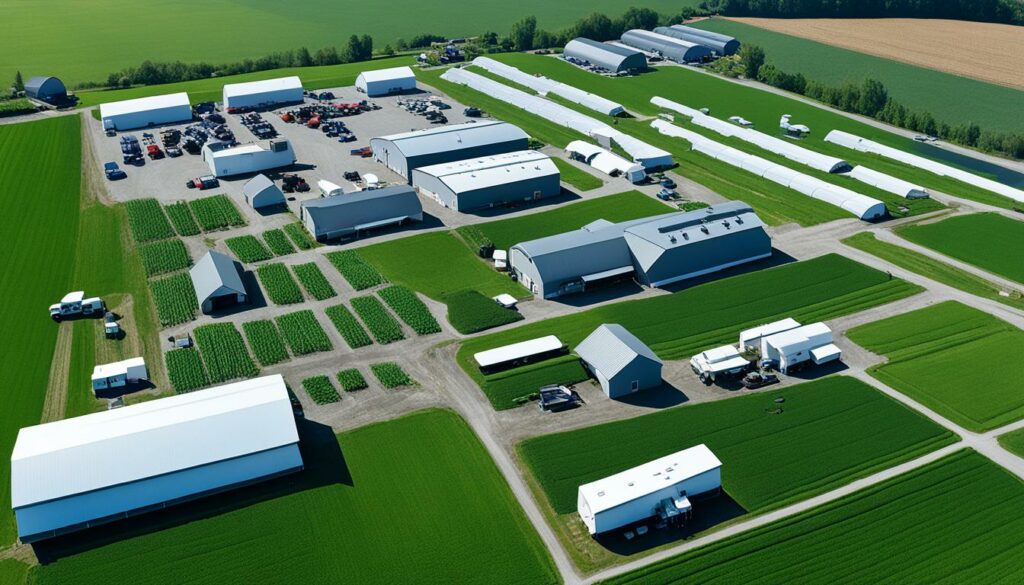
Important safety steps on the farm include turning off emergency valves, disconnecting electricity, and keeping fire extinguishers handily available. A clear emergency plan should lay out how to leave the area safely, handle spills, and who to call for help.
Taking a walk around the farm regularly helps find problem spots and update your response plan. It’s also wise to keep a list of everything important, like animals, food, machines, and medicines, to see what you might need in an emergency. Using maps to pinpoint dangers can assist responders in reacting fast.
Knowing who to contact right away is crucial for making fast and right decisions. Social media can help keep everyone connected and informed. Also, giving specific tasks to your team members makes sure everyone works together well. Plus, having maps ready for emergency crews helps them find their way around.
Working closely with fire chiefs and paramedics perfects your emergency strategy. Moving dangerous items away can protect both people and animals. And having various plans for moving animals or staying put keeps things organised and avoids confusion. Having a set meeting spot for your team helps make sure they’re all okay.
Keeping a schedule of daily jobs, like when to feed the animals, is vital for keeping the farm running smoothly no matter what. Making sure your staff are well-trained and ready is also important. Having enough medicine and first aid supplies on hand can help in emergencies.
Don’t forget about the farm’s business side. Be ready for how sudden market changes might affect you. Training backup helpers in advance can keep things going smoothly. Good planning and action in your farm emergency response protocol are key in handling issues and keeping the farm running safely and smoothly.
Being ready for emergencies is crucial in farming. It helps avoid or lessen the effects of disasters. Farmers must plan for risks that are particular to farming.
Natural disasters like floods, storms, and droughts are big threats. Their occurrence and strength are on the rise due to climate change. This makes having solid emergency plans very important.
Farmers need to think about safety from carbon monoxide, dangers from animals and insects, and mould. They should make emergency plans, get ready personally, and work with local emergency groups.
Helping rebuild the community after a disaster is vital. It boosts recovery and helps everyone cope better mentally. Knowing the local area and nature can lower the risks of future disasters. It also improves resilience over time.
Preparedness means keeping important contacts updated. It involves making plans for animal safety, keeping diseases away, and managing food supply well.
| Natural Disaster | Impact | Preparedness Strategies |
|---|---|---|
| Flooding | Property Damage, Crop Loss | Install Flood Defences, Drainage Systems |
| Hurricanes & Tornadoes | Structural Damage, Water Contamination | Secure Structures, Emergency Kits |
| Extreme Heat & Drought | Dehydration, Reduced Yields | Irrigation Systems, Shade Structures |
| Wildfires | Destruction of Land, Air Quality Issues | Clear Vegetation, Fire Breaks |
Focusing on being prepared in agriculture is key. It helps reduce disaster effects and keeps farming going. It’s about being ready now and for what might happen later.
When emergencies happen on the farm, keeping people safe and secure is key. It’s important to make a plan that focuses on everyone’s health and keeping the farm safe. Be sure to set up strong plans so that you deal with dangers well.
An emergency kit is a must for farmers. It should have things like feed, water, and health records for animals. FEMA says this is vital for many emergencies, from big natural disasters to health issues that can affect animals.
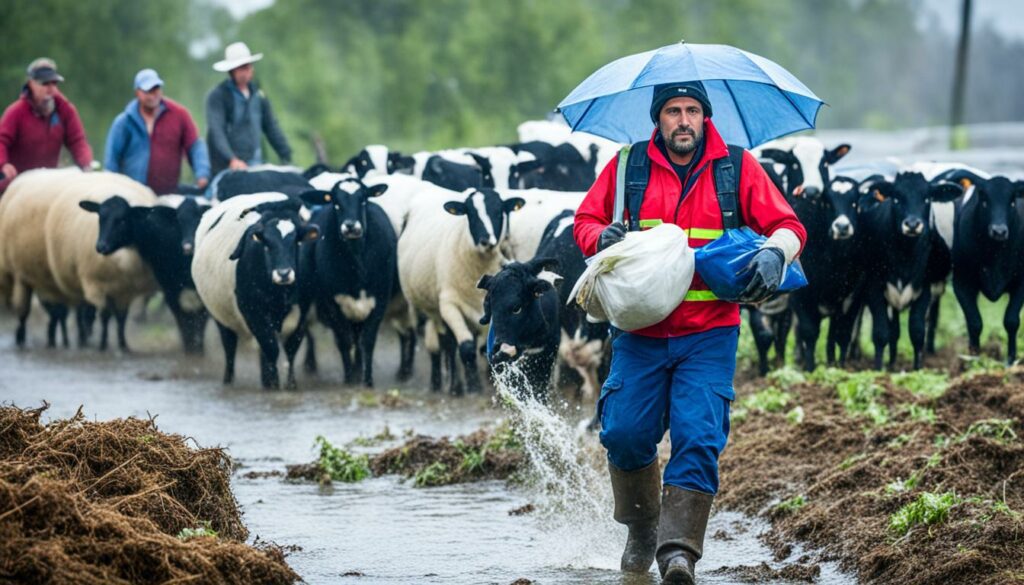
If you have to leave, knowing how to move animals safely is crucial. Friends or places like fairgrounds can help. But if you can’t leave, it’s vital that each animal is safe. They need food, water, and a place to stay that protects them from the weather.
Having a trusted neighbour to help with animals can make a big difference. They can also help get in touch with experts when things go wrong. Things like this help keep the farm safe and follow important safety rules.
It’s also key to listen to health experts and report accidents right. This follows the law and helps protect the farm when trouble comes. With a good plan in place, the farm is ready for anything that might happen.
| Emergency Preparation | Action Required |
|---|---|
| Emergency Kit | Prepare with feed, water, supplements, veterinary records, proof of ownership |
| Evacuation Plan | Identify and plan safe locations for livestock |
| Livestock Shelter | Provide sturdy and weather-resistant shelters |
| Neighbour Assistance | Designate a neighbouring farm for assistance |
| Contact Authorities | Engage local officials and response teams like the National Animal Health Emergency Response Corps |
| Adherence to Health Agencies | Follow OSHA guidelines for safety |
| Incident Reporting | Report to authorities such as EPA |
Legal matters in farm emergency planning cover a wide scope. It is vital to obey laws about reporting incidents, keeping the environment safe, protecting workers, and following health rules.
Obeying laws is a must when emergency situations happen on farms. If there’s a spill, it must be reported within 15 minutes. Farms should also have a spill kit ready. This helps keep the farm safe and follow the law at the same time.
Emergency plans must be filed in three places. These are with the emergency committee, at the farm office, and in tractor cabs. It’s not just paperwork. Doing this means everyone can get important details fast. For example, the Michigan Emergency Tube lets responders know where hazardous materials are.
Farmers should let local emergency teams check their plans. They can suggest how to make the plan better. It ensures the plan meets legal standards and really works. Also, making an emergency group on social media helps with quick, clear communication.
Keeping the emergency plan up to date is vital. Laws and farm activities can change. Regular checks and updating the plan helps to stay ready. Also, giving out maps can help responders find their way and know where dangerous items are stored.
Overall, including legal considerations in farm emergency planning is key to running things right and managing crises well. Regularly reviewing the plan, working closely with emergency teams, and having clear reporting rules are crucial. They help maintain legal standards and keep the farm, its workers, and the community safe during tough times.
In conclusion, planning for farm emergencies is crucial. It protects the farm, the environment, and nearby areas. Effective preparation starts with knowing and following the law. This includes safety steps and legal rules.
Research from groups like the Journal of the American Veterinary Medical Association shows how vital readiness is. They warn us about old and new dangers. For example, Foxell JW.’s work on farm attacks points out weak spots in our systems. This shows we need solid emergency plans.
Working with local and government emergency teams is key. Studies by Fitzpatrick AM. and Bender JB. on tackling germ attacks in farms, and reviews by Rushton J. and Upton M. about disaster response costs, reveal big differences. Good teamwork and clear talk can make our defenses stronger against emergencies.
Rural areas face unique obstacles, lacking some resources and structures. So, having a detailed emergency plan is crucial here. Regularly updating this plan is vital. It helps control risks and ensures quick, united actions in crises. This is how farm owners can protect their businesses and help the farming sector stay strong.
Stick to mandatory spill reporting. Ensure the safety of farm chemicals. Also, follow local and national rules on the environment and safety strictly.
Create a plan that spots risks and sets out what to do in emergencies. It should include talking to local emergency services and preparing for spills. Keep it up to date with regular checks.
Check the plan at least every year. Also, update it after any big changes on the farm. This keeps the plan useful and on track.
Make sure you meet all safety laws. Report any spills or incidents. And always be ready to work with government departments in an emergency.
Know the latest rules from both state and national levels. Use them in your planning. Work closely with local emergency teams for better coordination.
Authorities like FEMA guide on disaster prep. The SBA and Agriculture Dept. offer loans for recovery. This helps after severe damage to your farm.
Have absorbents, safety gear, and tools to contain spills. And always report spills fast to the right authorities to follow the law.
Not following the rules or being careless in emergencies can lead to fines. You might also have to pay for damages, which can be costly.
Working with local services like the fire department helps a lot. They get to know your farm better, making emergency plans more effective.
Insurance helps cover costs from disasters. It protects against damages and lawsuits. Always check your policies to make sure they’re enough.
Look after people’s safety and keep farms secure. Have plans for safety and follow advice from health agencies to prevent any dangers.
Look at both accidental and natural risks, like chemical spills or floods. This helps you focus on the main dangers and get ready to respond well.
Not having a good plan or not following it might lead to penalties. How bad the punishment is depends on how much you neglected your responsibilities. Always be proactive and follow the law.
Being ready for emergencies tackles unique dangers in farming. It means training staff, buying safety gear, and knowing the rules. This helps lessen disaster effects and keeps your farm going strong.
Put down what to do in different emergencies. Include escape plans, ways to stop spills, and how to call emergency services fast. This is key for a quick and legal response to emergencies.